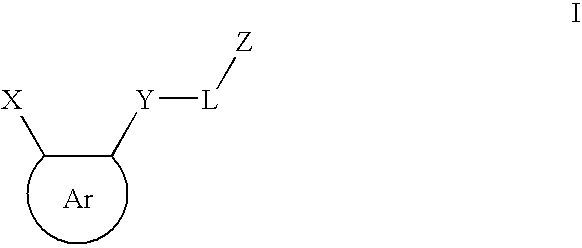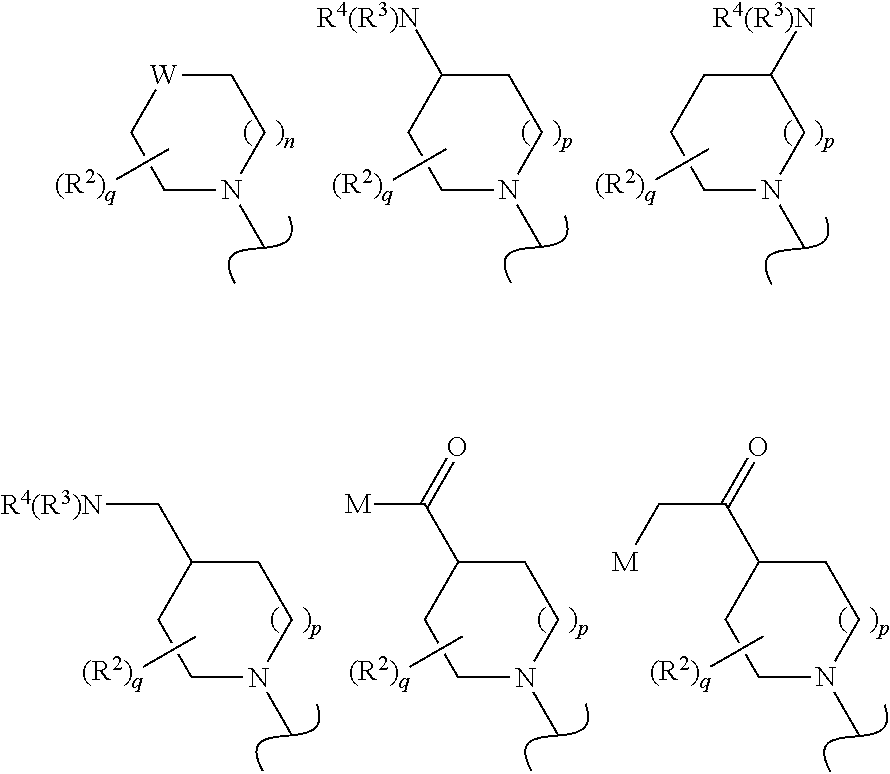Tie-2 modulators and methods of use
a technology of protein kinase and modulator, which is applied in the direction of peptides, drug compositions, immunological disorders, etc., can solve problems such as cellular properties that are not suitable for use, and achieve the effect of improving the specificity of the agent used
- Summary
- Abstract
- Description
- Claims
- Application Information
AI Technical Summary
Benefits of technology
Problems solved by technology
Method used
Image
Examples
example 1
4-[4-(Pyridin-4-ylmethoxy)-[1,2,5]thiadiazol-3-yl]-piperazine-1-carboxylic acid (3,5-bis-trifluoromethyl-phenyl)-amide
[0210]
[0211]4-(4-Chloro-[1,2,5]thiadiazol-3-yl)-piperazine-1-carboxylic acid tert-butyl ester: 1-Boc-piperazine (30.2 g, 165 mmol) was dissolved in DMF (30.0 mL) and heated to 100° C. 3,4-Dichloro-1,2,5-thiadiazole (7.5 mL, 80 mmol) was added dropwise with stirring and the mixture heated at 100° C. for 5.5 h. The reaction mixture was diluted with H2O and the pH adjusted to 2.0 with 1N HCl. The resulting solids were filtered, washed with H2O and dried under vacuum to give 20.1 g (83%) of 4-(4-chloro-[1,2,5]thiadiazol-3-yl)-piperazine-1-carboxylic acid tert-butyl ester as a tan solid. 1H NMR (DMSO-d6) 3.48 (m, 4H), 3.36 (m, 4H), 1.42 (s, 9H) ppm. LC-MS (MH+)=205 (-Boc).
[0212]4-[4-(Pyridin-4-ylmethoxy)-[1,2,5]thiadiazol-3-yl]-piperazine-1-carboxylic acid tert-butyl ester. 4-(4-Chloro-[1,2,5]thiadiazol-3-yl)-piperazine-1-carboxylic acid tert-butyl ester (10.0 g, 33 mmol)...
example 2
N-[3,5-bis(trifluoromethyl)phenyl]-4-{4-[(pyridin-4-ylmethyl)oxy]-1,2,5-thiadiazol-3-yl}-1,4-diazepane-1-carboxamide
[0215]
[0216]A mixture of t-butyl 1-homopiperazine carboxylate (45 mmol, 9 g) and DMF (50 ml) was heated to 100° C. 3,4-dichloro-1,2,5-thiadiazole (23 mmol, 2.2 ml) was added dropwise to the mixture with stirring. The resulting mixture was stirred at 100° C. for 2 days. Mixture was quenched with ice / water and extracted with ethyl acetate (3×). The combined organic layer was washed with water (2×) and Sat. sodium chloride, dried over sodium sulfate, filtered and concentrated. The crude was purified on a silica column using 20% ethyl acetate / hexanes to give 4-(4-chloro-[1,2,5]thiadiazol-3-yl)-[1,4]diazepane-1-carboxylic acid tert-butyl ester (5.8 g). The material thus obtained was converted into the title compound by following the same procedures as in Example 1. 1H NMR (CDCl3) 9.52 (s, 2H), 7.838 (s, 2H), 7.508 (s, 1H), 7.321-7.307 (d, 2H), 6.769 (br. s, 1H), 5.464 (s, 2...
example 3
2,6-Dimethyl-4-[4-(pyridin-4-ylmethoxy)-[1,2,5]thiadiazol-3-yl]-piperazine-1-carboxylic acid (3,5-bis-trifluoromethyl-phenyl)-amide
[0217]
[0218]1-(4-Chloro-[1,2,5]thiadiazol-3-yl)-3,5-dimethyl-piperazine. 2,6-Dimethyl-piperazine (8.1 g, 71 mmol) was heated to 100° C. in DMF (8.0 ml). 3,4-Dichloro-1,2,5-thiadiazole (3.3 ml, 35 mmol) was added and the mixture stirred at 100° C. for 3-4 h. The reaction mixture was poured into H2O and extracted with EtOAc (4×). The combined EtOAc extractions were washed with sat'd NaHCO3 (1×), sat'd NaCl (1×), dried (Na2SO4), and concentrated in vacuo to give 7.9 g (97%) of 1-(4-chloro-[1,2,5]thiadiazol-3-yl)-3,5-dimethyl-piperazine which was used without further purification. 1H NMR (CDCl3) 3.90-3.86 (m, 2H), 3.05 (m, 2H), 2.52 (m, 2H), 1.12 (d, 6H) ppm. LC-MS (MH+)=233.
[0219]3,5-Dimethyl-1-[4-(pyridin-4-ylmethoxy)-[1,2,5]thiadiazol-3-yl]-piperazine. 1-(4-Chloro-[1,2,5]thiadiazol-3-yl)-3,5-dimethyl-piperazine (7.9 g, 34 mmol), pyridinyl-methanol (7.7 g,...
PUM
| Property | Measurement | Unit |
|---|---|---|
| body weight | aaaaa | aaaaa |
| temperature | aaaaa | aaaaa |
| temperature | aaaaa | aaaaa |
Abstract
Description
Claims
Application Information
 Login to View More
Login to View More - R&D
- Intellectual Property
- Life Sciences
- Materials
- Tech Scout
- Unparalleled Data Quality
- Higher Quality Content
- 60% Fewer Hallucinations
Browse by: Latest US Patents, China's latest patents, Technical Efficacy Thesaurus, Application Domain, Technology Topic, Popular Technical Reports.
© 2025 PatSnap. All rights reserved.Legal|Privacy policy|Modern Slavery Act Transparency Statement|Sitemap|About US| Contact US: help@patsnap.com



